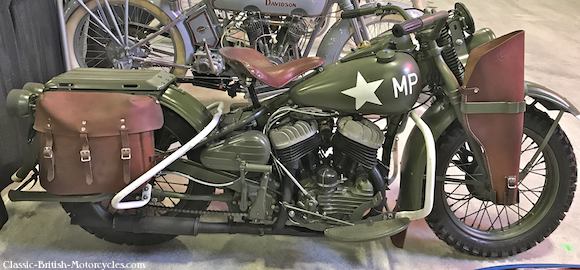1942 HARLEY-DAVIDSON WLA – WHAT’S IN A NAME?
The nomenclature “WLA” stands for something, as you probably suspected. The “W” signifies the ‘family’ of motorcycles within the Harley family tree. The W-series was their 45 cubic-inch flathead (side valve) single (only one seat) that was their entry-level V-twin in the civilian market. It had superseded the earlier R-series (1932-1936). The “L” means it was a high-compression engine, which for an antique flathead engine like this is still only 5:1. There were lower-compression WA’s as well, although very few were built. The “A” means Harley built it for the US Army. They also built bikes for the Canadian Army, to a slightly different specification, and those were designated “WLC”. Strangely, all WLAs built after Pearl Harbor (Dec. 7, 1941) were titled as 1942 models, and are known as 42WLAs. The Canadian-version WLCs were all produced in, and titled as 1943 and are known as 43WLCs. While the frames were never numbered, engines are sequentially-numbered, and even though they all use the same 42WLA designation, it is possible to accurately identify the year, and even the month of manufacture of the engine.

1942 HARLEY-DAVIDSON WLA BACKGROUND
Harley had already been producing the civilian version of the WLA, the WL, since 1937. The WL had evolved out of the earlier R-series which ran from 1932-1936. The US government awarded Harley-Davidson the entire contract for producing all its wartime motorcycles, much to the chagrin of Indian, who was struggling before the war and now continued to struggle as Harley built some 90,000 WLAs during World War II.


1942 HARLEY-DAVIDSON WLA SPANS THE GLOBE
Harley-Davidson built WLAs, and variants of it for not only the US Army, Navy, Army Air Corps and Marine Corps (WLA), they also built them for Canada (WLC), South Africa, and even the Soviet Union who bought 30,000 of them under the Lend-Lease program. While production ceased at the end of World War II, it resumed again with the advent of the Korean War, and ran from 1949-1952.


1942 HARLEY-DAVIDSON WLA DESIGN
The WLA, and the WL civilian bike it was based on, are rugged, robust designs, not meant to be lightweight, sophisticated or even particularly efficient. The flathead engine design was low on power, compared to the OHV engines being used on Harley’s Big Twins by this time. But they were tough, robust, even indestructible, and totally reliable. And they could be worked on with simple tools and very little skill, the kind of skills possessed by young American GIs fresh off the farm. This exact engine remained in production from 1937 through 1973 in Harley’s 3-wheeled Servi-Car. While supposedly a high-compression engine (for a flathead), the US Army actually specified a slightly lower compression ratio, 5.0:1, in the interest of reliability. So, the WLA was really more of a ‘medium-compression’ engine, and because of it, required 74-octane gasoline. The frame and suspension were typical pre-war Harley stuff, a springer front fork and a rigid frame. Above all, the 1942 Harley-Davidson WLA was meant to be unstoppable in the field of battle, and for the most part, they succeeded in spades.

1942 Harley-Davidson WLA SPECIFICATIONS
|
Model designation Engine type Displacement Bore & Stroke Compression ratio Fuel system Ignition system Electrical system Primary drive Clutch Gearbox Final drive Suspension, front Suspension, rear Brake, front Brake, rear Wheelbase Length Width Height Weight, dry Top speed |
1942 Harley-Davidson WLA Air-cooled, side-valve, 45-degree V-twin 45.12 ci / 739 cc 2.745″ X 3.8125″ 5.0:1 1 – Linkert carburetor Battery, coil & points 6-volt, negative-ground Chain Multi-plate, wet, foot-operated 3-speed, left-hand shift Chain Springer Rigid SLS drum SLS drum 57.5″ / 1460.5 mm 87.8″ / 2230 mm 35.4″ / 900 mm 40.0″ / 1040 mm 540 lbs / 245 kg 59 mph / 95 kmh |


